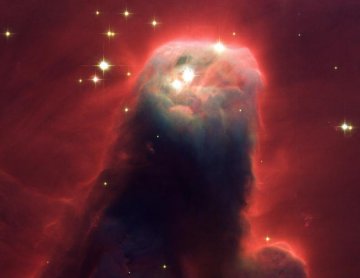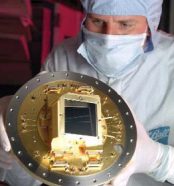Space Camera Glitch
The sharpest, most sensitive camera on the aging Hubble Space Telescope has stopped working.
Share this:
- Share via email (Opens in new window) Email
- Click to share on Facebook (Opens in new window) Facebook
- Click to share on X (Opens in new window) X
- Click to share on Pinterest (Opens in new window) Pinterest
- Click to share on Reddit (Opens in new window) Reddit
- Share to Google Classroom (Opens in new window) Google Classroom
- Click to print (Opens in new window) Print
By Emily Sohn
NASA has announced some bad news about the Hubble Space Telescope. The spacecraft has been orbiting Earth and collecting information about space since 1990. Now, Hubble’s sharpest camera has died, and there’s no way to bring it back to its full power.
Until it broke down, the Advanced Camera for Surveys (ACS) was the most popular instrument on board, accounting for two-thirds of the observations made by the orbiting telescope. It also captured the deepest picture ever taken of the universe, which reveals disks of gas and dust turning into planets around other stars. The ACS was installed in March 2002.
 |
|
Since 2002 the Hubble Space Telescope’s Advanced Camera for Surveys has been producing spectacular pictures of space, such as this image of the Cone Nebula, a star-forming pillar of gas and dust. |
| NASA, H. Ford (JHU), G. Illingworth (UCSC/LO), M. Clampin (STScI), G. Hartig (STScI), the ACS Science Team, and ESA. |
Trouble struck on Jan. 27, when Hubble suddenly went into “safe mode.” This means that it shut off detectors that it didn’t need, including several in the ACS. An investigation showed a glitch in the electrical system that powered the camera.
As a result, two sensors on the ACS that detect visible light failed. Since last June, those detectors had been running off backup power after another problem with the spacecraft’s main power supply.
“The seemingly permanent loss of the ACS is a blow to the astronomical community,” says astronomer Lynne Hillenbrand of the California Institute of Technology in Pasadena.
Near the end of February, engineers plan to switch the Hubble camera back to the original power system. They hope the changeover will revive a detector that collects ultraviolet light.
 |
|
This photo shows a piece of Hubble’s Advanced Camera for Surveys before the camera was assembled and installed in space. |
| Ball Aerospace & Technologies Corp. |
Sometime in early February, three more instruments should come back online—including a less sensitive camera that uses visible light, a camera that detects near-infrared light, and fine-guidance sensors, which track the motions of stars.
By collecting light in longer exposures, the Hubble’s wide-field camera might be able to fill in for the ACS in some cases. And NASA points out that it has plenty of projects to keep Hubble’s remaining instruments busy.
Astronauts will return to the spacecraft in September 2008 to service and repair the telescope. They’ll install a new infrared camera and a sensitive ultraviolet spectrograph, which measures wavelengths of light. They will also try to fix a spectrograph that has stopped working. Repairs to the ACS itself would be too risky and take too much effort to be worthwhile.
As originally planned, Hubble was scheduled to operate until 2010. This date is approaching rapidly, Hillenbrand says. More hardware failures like this one are increasingly likely in the coming years.—E. Sohn
Going Deeper:
Cowen, Ron. 2007. Kaput: Hubble’s main camera stops working. Science News 171(Feb. 3):68. Available at http://www.sciencenews.org/articles/20070203/fob3.asp .
You can learn more about the Hubble Space Telescope’s Advanced Camera for Surveys and images that it has provided at hubblesite.org/newscenter/archive/releases/2002/11 (Space Telescope Science Institute).






